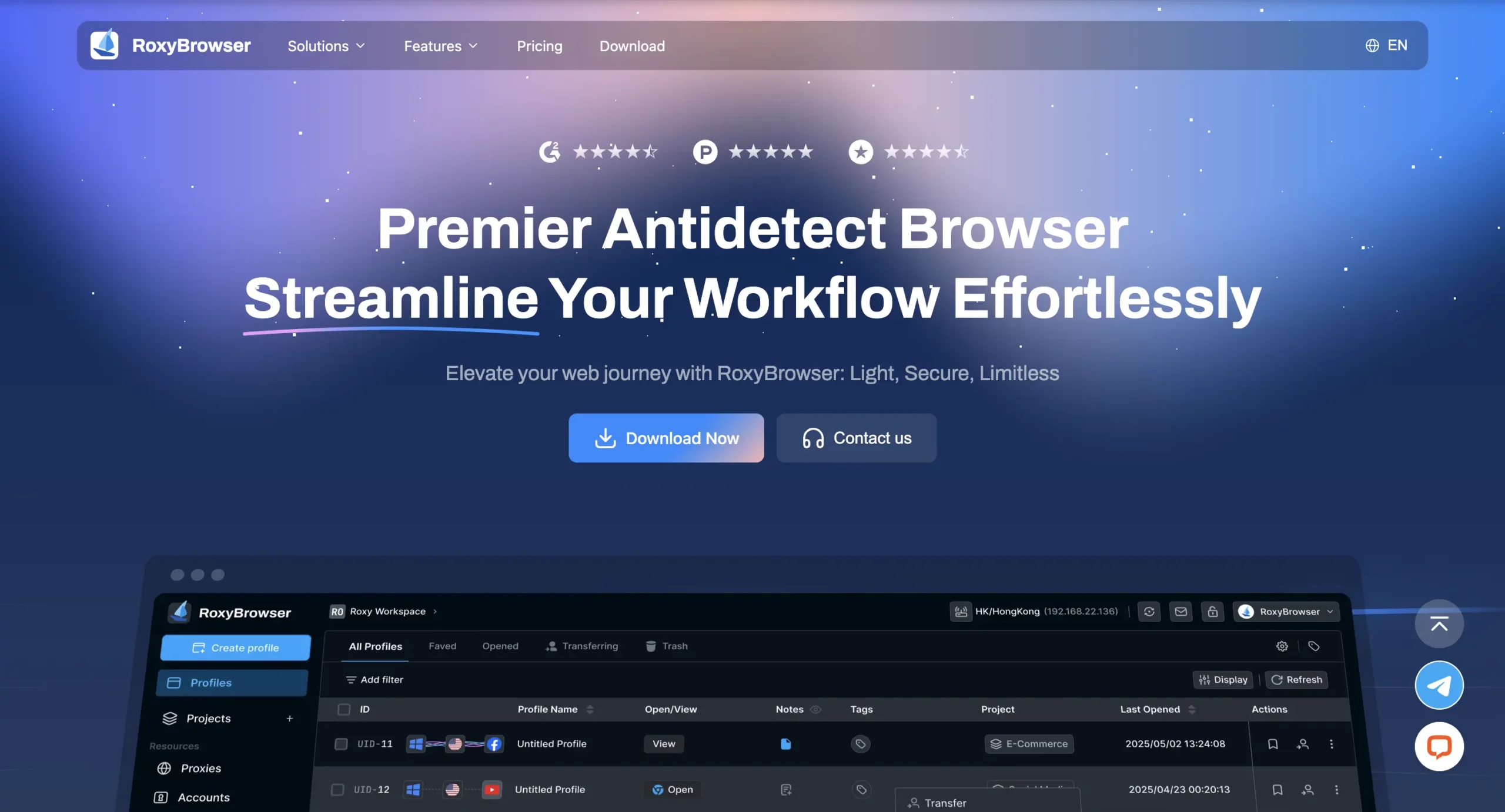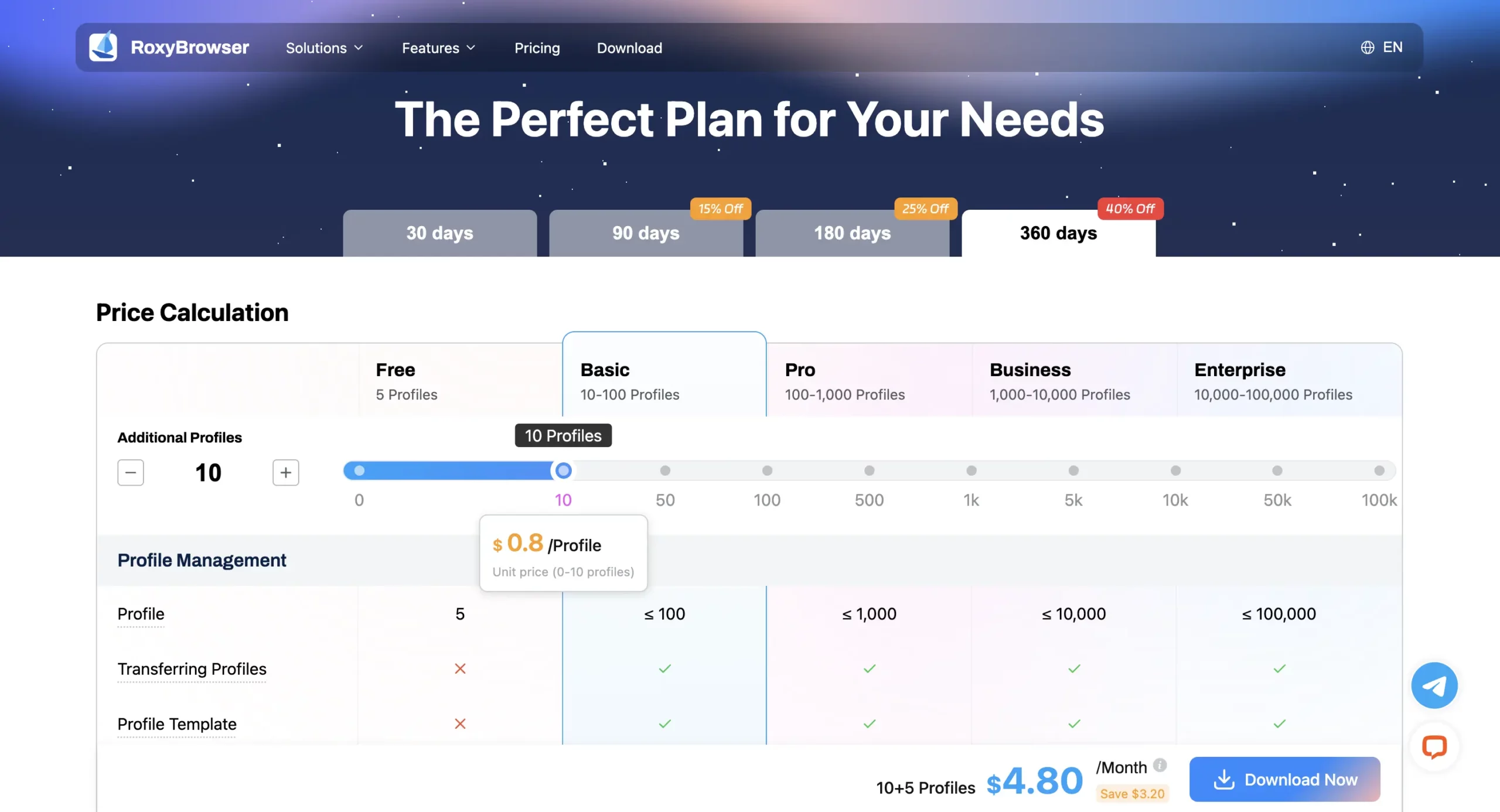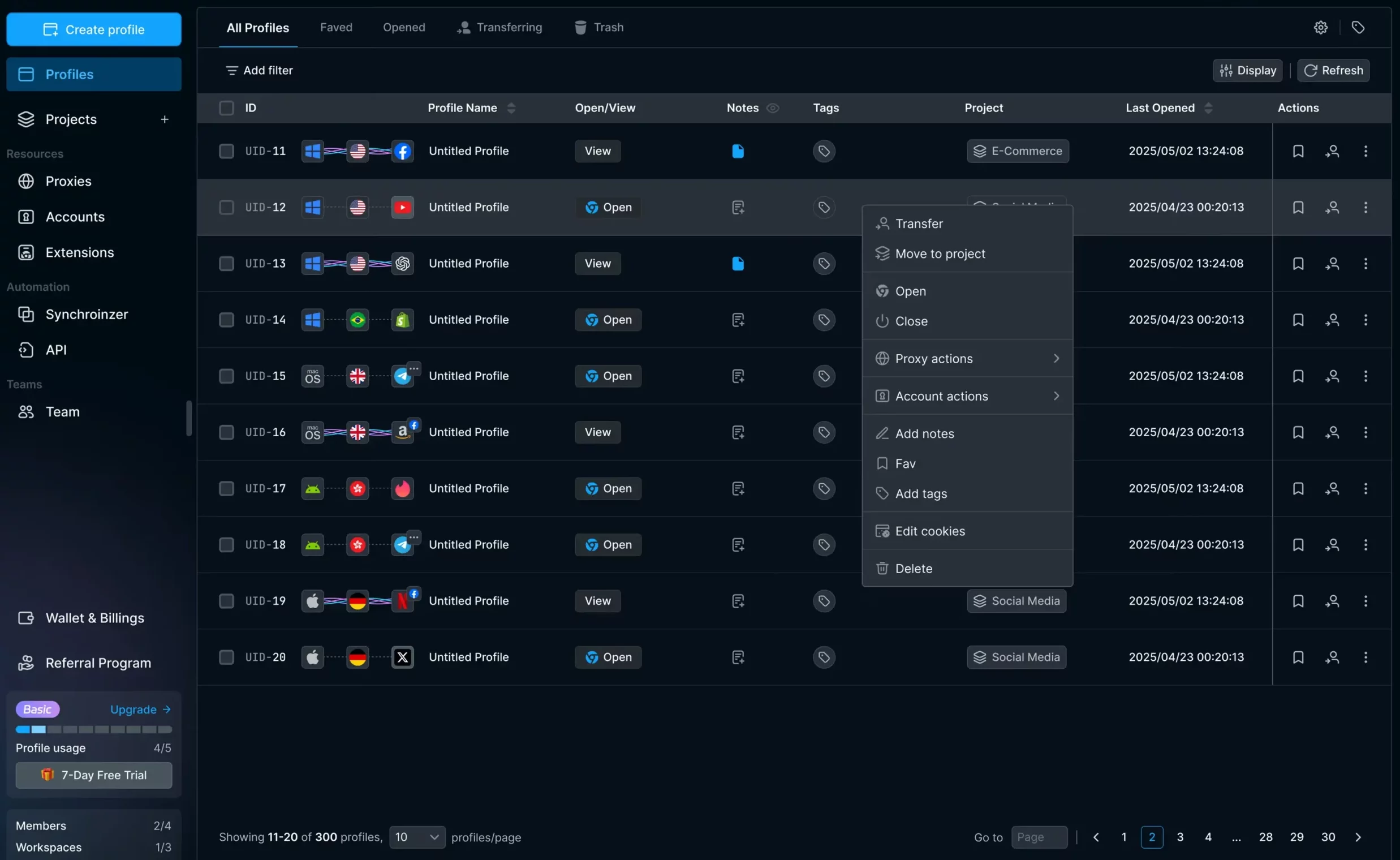RoxyBrowser User? Get Your Exclusive 50% Discount!
RoxyBrowser is a Chromium-based antidetect browser designed to help users manage multiple online accounts efficiently and securely. With its advanced fingerprint customization capabilities and streamlined workflow features, it’s particularly popular for e-commerce, affiliate marketing, social media management, and web scraping activities.
Unlike other tools, Roxy Browser only stores profiles on your local machine—there’s no cloud backup or sync. That means you can’t pick up where you left off on a different computer, and your team can’t instantly share profiles. You lose the speed and convenience that cloud profiles offer. If you need easy access and fast collaboration, a tool with cloud and local options is a better fit.
What is RoxyBrowser?

How to sign up to RoxyBrowser?
Getting started with Roxy Browser is straightforward and requires just a few steps:
- Visit the official website at roxybrowser.com
- Click on the “Download Now” button prominently displayed on the homepage
- Install the application on your Windows, macOS, or Linux device
- Launch the application and create your account directly within the app
- Choose between the free trial option (which includes 5 profiles) or select a paid plan
- Complete the registration process with your email address
- Begin creating and customizing your browser profiles immediately
The signup process is designed to be user-friendly, with clear instructions guiding you through each step. Unlike some competitors that require complex verification processes, Roxy Browser keeps the onboarding experience simple and efficient.
RoxyBrowser: Setting up custom profiles
To set up a new profile in RoxyBrwoser, simply click the “Create Profile” button in the dashboard. From there, you can customize various aspects of your digital fingerprint:
Browser version: Select specific Chromium versions to match your target platforms
Screen resolution and color depth: Customize to match common device configurations
Language and timezone settings: Set to match your target geographic location
WebRTC, Canvas, WebGL, and AudioContext fingerprints: Modify to prevent tracking
User agent strings: Customize how your browser identifies itself to websites
For proxy integration, Roxy Browser supports HTTP, HTTPS, SOCKS4, SOCKS5 proxy types and allows you to assign different proxies to different profiles.
Note:RoxyBrowser doesn’t offer built-in proxies—you’ll need to find and configure them on your own. This hands-on setup adds a layer of complexity, involving manual configuration, testing, and continuous upkeep. Additionally, RoxyBrowser supports only a narrow range of proxy providers, so you’ll have to confirm that your chosen service is compatible. A single misstep in configuration can reveal your real IP or lead to account bans, jeopardizing your entire multi-account operation.
Key features of RoxyBrowser
Roxy Browser offers a set of features designed to enhance your multi-account management experience:
Multi-platform support for Windows, macOS
Profile organization with projects and tagging system
Automation support via API, Selenium, and Puppeteer
Browser extension management with the ability to install extensions per profile
Profile import/export functionality for backup and transfer
Bulk actions for efficient management of multiple profiles
Detailed activity logs for monitoring and troubleshooting
The browser also includes practical tools like a built-in notes system for each profile, allowing you to keep track of account details and access credentials securely within the application.
Pros of RoxyBrowser
Intuitive User Interface: Roxy Browser features a clean, modern interface that makes profile management straightforward—even for beginners. The visual layout and color-coded profiles help users stay organised while managing multiple accounts. However, it’s worth noting that the interface bears a strong resemblance to GoLogin’s UI, raising concerns about originality and innovation
Fingerprint customization: RoxyBrowser offers enough fingerprint settings for smaller teams who need to manage multiple accounts with basic anonymity.
Flexible proxy integration: Roxy Browser allows users to connect with any third-party proxy provider, offering flexibility to choose based on performance or pricing needs. However, since proxies aren’t built-in, this means users will need to budget separately for proxy services—raising the total cost beyond the advertised plan.
Cross-platform compatibility: Unlike some competitors that are limited to Windows, Roxy Browser works across Windows, macOS, making it accessible to a wider range of users regardless of their preferred operating system.
Cons of RoxyBrowser
No Built-in Proxies: While the flexibility to use any proxy provider is beneficial for many, new users might find it challenging to source and configure their own proxies without integrated options.
Learning Curve for Advanced Features: Though the basic functionality is user-friendly, mastering the more advanced fingerprinting and automation features requires time and technical knowledge.
Resource Intensive at Scale: When running a very large number of profiles (50+) simultaneously, users with older hardware may experience performance issues, requiring more powerful systems for optimal performance.
Documentation Could Be More Comprehensive: While the basic documentation is adequate, more detailed guides for advanced features and troubleshooting would be beneficial, especially for new users.
RoxyBrowser: Usability, prominent features & interface
Usability
Roxy Browser tries to be easy to use, but it still feels basic compared to more advanced tools. The layout is clean, but for users who need to manage lots of profiles or work fast, it can feel slow and limited.
The dashboard shows simple info like profile status and last use, but doesn’t give much detail. Bulk actions are there, but they’re not powerful enough for bigger teams or serious multitasking. Team features like access control and sharing exist, but they’re pretty simple. If you’re working in a busy agency or need smooth team workflows, Roxy might not give you the flexibility or control you need.
RoxyBrowser: Performance
RoxyBrowser delivers reasonably solid performance in core areas, though it doesn’t significantly outshine competitors—especially those with more mature optimization frameworks.
Startup speed: Profile launch times are acceptable, with only a slight delay before the browser window becomes usable. However, during tests with larger sets of profiles or lower-end hardware, occasional lags were observed—especially when switching between multiple sessions.
Memory management: RoxyBrowser handles memory decently under moderate loads. While RAM usage is generally under control, efficiency may drop during extended sessions or when running high numbers of concurrent profiles, which could impact performance in more demanding workflows.
Stability: Crashes appear infrequent in light to moderate use, but some users have reported occasional freezing or profile glitches when pushing the browser to scale—particularly during batch operations or high-frequency automation.
Isolation effectiveness: Profile separation is functional and prevents basic cookie and cache crossover. However, deeper fingerprint isolation layers (like audio context, WebGL, or timezone spoofing) offer less transparency.
Cross-platform consistency: RoxyBrowser performs more smoothly on Windows compared to macOS, where users have reported slightly slower load times and less responsive navigation.
RoxyBrowser: Proxy Management
- IP leakage: Misconfigured proxies can expose your real IP address, defeating the purpose of using an antidetect browser
- Account bans: A single misconfigured proxy can trigger security systems and lead to permanent account suspensions
- Time-consuming setup: Each profile requires individual proxy configuration, creating workflow inefficiencies
RoxyBrowser: Fingerprint features
Note: Roxy Browser is available only on Windows and macOS—Linux users will need to consider other antidetect browsers for native support.
Roxy Browser’s fingerprinting system offers:
Roxy Browser advertises “advanced fingerprint simulation” but doesn’t list which parameters you can tweak, leaving users unsure exactly how much control they have.
RoxyBrowser: Pricing and plans

Roxy Browser offers a structured pricing model designed to accommodate different user needs:
Free plan: 5 profiles, basic features, 7-day trial
Basic plan: 10–100 profiles, starting at $4.80/month (billed annually)
Pro plan: 100–1,000 profiles with advanced features and team access
Business plan: 1,000–10,000 profiles with priority support and advanced automation
Enterprise plan: 10,000–100,000 profiles, custom solutions, and a dedicated account manager
Note: Proxy traffic ($3/GB), additional workspaces ($10/workspace), and extra team seats (~$5/seat) are not included in these base prices—once you factor in those add-ons, the overall cost can rise significantly, making the initially low sticker price far less affordable than it first appears.
Conclusion
Compare RoxyBrowser with Multilogin—an all-in-one antidetect browser with built-in residential proxies, cross-platform support, and clear guides—and get 50% off your first month to see how much smoother your workflow can be.
Compare RoxyBrowser with Multilogin now! Discover your best fit & get 50% off your first month!
RoxyBrowser FAQ
The number of profiles depends on your subscription plan. The free trial offers 5 profiles, while paid plans range from 10 profiles (Basic plan) up to 100,000 profiles (Enterprise plan).
No, Roxy Browser operates exclusively as a local application with no cloud synchronization. Your profiles are stored only on your device, and you would need to manually export/import profiles to use them on different computers.
Roxy Browser offers standard fingerprinting features and a clean interface but lacks some advanced capabilities found in more established competitors. Its local-only approach and lack of built-in residential proxies are notable limitations compared to more comprehensive solutions.
While Roxy Browser can technically handle larger numbers of profiles, users report performance issues when running 50+ profiles simultaneously, especially on older hardware. For large-scale operations, more robust solutions might be preferable.



